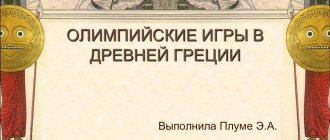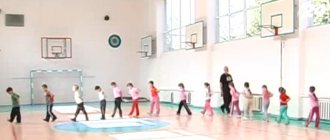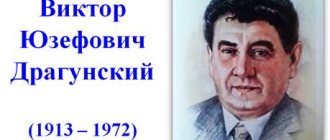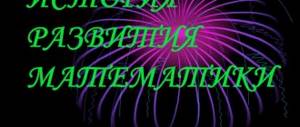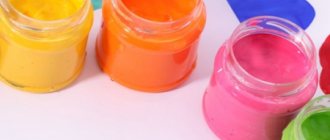Conversation for children of the senior preparatory group with a presentation: What is paper?
Conversation for children 5-7 years old with presentation: “What is paper?”
Author: Tatyana Nikolaevna Dvoretskaya, GBOU School No. 1499 DO No. 7 Educator Description: The conversation is intended for children of senior preschool age, preschool teachers, and parents. Purpose of the work: The conversation will introduce children to the stages of paper production. Goal: to develop a careful attitude towards paper in preschool children.
Objectives: 1. captivate children with an interesting story about paper production; 2. introduce children to the stages of paper production; 3. instill in children of senior preschool age a careful attitude towards paper; 4. to develop children’s environmental culture and skills in rational environmental management; Epigraph: Children are young creators, they draw all kinds of pictures every day. Sometimes the drawing doesn’t work out and the children throw it in the trash. Kindergarten teachers need to teach children to be careful with paper. Conversation: What is paper? Presenter: Guys, look what I’m holding in my hands? (Sheet of paper) Yes, this is an ordinary sheet of paper on which you like to draw. Slide No. 1 And you know that before there was no paper. What happened instead? To find out the answer to this question, scientists studied ancient manuscripts and excavated ancient cities for many years. So where did paper come from? It turns out that a long time ago people wrote on birch bark. What is birch bark? (Children's answers) Slide No. 2 Birch bark is the outer part of birch bark (showing birch bark).
Scientists found birch bark letters during excavations of the ancient city. These are letters and documents written on birch bark. The letters are scratched with special bone tools. But this method of writing was inconvenient, since the birch bark scrolls took up a lot of space. Slide No. 3 Then people came up with sheets of thin skin of young animals - parchment .
It is a very durable material (sample showing thin leather). Previously, there were even entire parchment books. To protect them from scratches, they were bound with copper, and the book resembled a chest.
This similarity was complemented by clasps and sometimes locks. Such books were voluminous and took up a lot of space. But time passed, and a new material appeared that was much thinner than parchment. In ancient China they came up with a recipe for making paper. It was easy and convenient to write on. This material was admired by all countries as a curiosity, but the wonderful method of making it was kept strictly secret. Many years passed and residents of other countries learned how to make this miracle. What do you think paper is made from? (Children's answers) If children find it difficult to answer, let's turn to the riddle. Slide No. 4 Riddle: In a fur coat in the summer, but undressed in the winter. (Trees)
A tree is a perennial plant that has one solid stem (trunk), roots, branches and leaves. Think and name the products that are made from wood? (Children's answers) Slide No. 5 Trees are the wealth of our nature. Wood is used to make: furniture, boards, wooden houses, pencils, paper, matches and much more. Slide No. 6 In order to find out how paper is made from wood, you need to go to a paper factory. It is there that logs cut from the forest are brought.
At the factory, the bark is stripped from the trees, crushed into chips, and the chips are sorted, special aqueous solutions are added, and sent for cooking.
Slide No. 7 There are two types of wood processing: 1. Mechanical method The paper turns out to be fragile and is used for the production of newspaper. Slide No. 8 2. Chemical method Paper pulp is obtained from wood, which goes into a paper-making machine, in which there are many, many rollers.
Slide No. 9 Some rollers are wrung out, others are dried, and others are polished. This way, moving from roller to roller, our wood turns into high-quality white paper. Slide No. 10 Tell me guys, why do people need paper? (Children's answers) Host: Many objects around us are made of paper. Look and name these items. (Children's answers) 1. School supplies: books, textbooks, notebooks, notepads, sketchbooks, colored paper; 2. Products for the apartment: newspapers, magazines, wallpaper, napkins, toilet paper; 3. Packaging products: boxes, containers, wrapping paper, etc. All this requires a lot of paper. At the same time, forest areas are rapidly shrinking. In order not to cut down forests, people came up with the idea of handing over waste paper and making paper from it. Slide No. 11 Waste paper is paper products used in everyday life (old newspaper, notebooks, magazines, boxes, etc.) This is how paper gets a second life and is called recyclables.
Slide No. 12 Let's learn to save paper! In our kindergarten, a waste paper collection campaign was prepared and carried out. The interaction of parents, students and teachers brought benefits to the environment and joy to the participants of the action.
Slide No. 13 Together we managed to collect 350 kilograms of waste paper. It is especially pleasant to note the fact that 250 kilograms were collected by activists of our group. Slide No. 14 October 24th is International Paperless Day. The motto of the day is to teach people to use paper rationally (economically).
Slide No. 15 Our achievements: - We have learned to save paper! - We found out how paper appeared! — We learned to draw beautiful trees! — We learned how to collect and hand over waste paper! — We saved the trees from being cut down!
Slide No. 16 THANK YOU FOR YOUR ATTENTION! Recommendations: In order to update children’s knowledge, conduct a conversation: What do trees give people?
— Trees are long-lived plants (age from 100 to 300 years) — Trees are a “home” for animals and birds (hollow and nests) — Trees are a “forest dining room” for birds and animals (fruits and seeds) — Trees purify and humidify the air , create coolness in the summer heat.
— Fruit trees — produce delicious edible fruits. “Trees benefit us even when they are cut down.” — Sawn wood is a building material: dried trunks are used to make boards, plywood, furniture, toys, and paper. — Trees grow slowly, so they need to be protected, protected and taken care of. — Young trees need to be planted in the spring. — Every second tree cut down on Earth dies to make paper. “Every day, people throw away huge amounts of paper, polluting the environment, instead of reusing it. Presentation on the topic: What is paper?
We recommend watching:
Conversation with children of the preparatory group on the topic “Blossoming of the meadow” Summary of the conversation in the preparatory group on the topic “Signs and sayings about autumn” Creative meeting of Maya Nikolaevna Shilova with kindergarten students Ecological conversation about forest dangers for older preschoolers (5-7 years old)
Similar articles:
Conversation on the topic “Fruits” in the senior preparatory group
Summary of the conversation in the senior group “Good will not die, but evil will disappear”
Conversation about generosity and greed with children of the senior preparatory group
Conversation for children “A lie does not make a person beautiful.” Senior group
Conversation about the Constitution for older preschoolers
Presentation “How paper is made” presentation on design, manual labor on the topic
Slide 1
How is paper made? Performed by teacher Dunaeva N.V.
Slide 2
Paper was invented in China around 105 by Cai Lun. He found a way to make paper from the fibrous inner bark of the mulberry tree.
Slide 3
In ancient historical times, when the Chinese had not yet invented paper, people wrote on different materials. The Egyptians wrote on papyrus, some on tree leaves, and some on ordinary wooden tablets covered with wax, then they came up with parchment for writing - this is processed and dried animal skin.
Slide 4
How is paper made nowadays? To produce paper, firstly, wood is needed, and secondly, a lot of water is required. Therefore, it is most convenient to build paper mills on the banks of rivers near forests; In addition, the rivers can be used for rafting.
Slide 5
Spruce, pine, and birch are used as wood, but other plant materials, such as straw or cotton, can also be used. Paper waste is also used for paper production - waste paper, scraps of fabric, which helps reduce deforestation.
Slide 6
Paper production begins with logs being delivered to the mill by river or by land.
Slide 8
Special machines remove the bark from the logs, after which they are cut into logs of equal length
Slide 9
To make paper from wooden logs, they are crushed, and the resulting mass is boiled for several hours with the addition of special chemicals, as a result of which the wood turns into tiny fibers - cellulose
Slide 10
Depending on what kind of paper we want to get, chemically untreated wood pulp or shredded waste paper can be added to these fibers. Then substances for strength and dyes are added. As a result, we obtain finished paper pulp that can be fed into a papermaking machine
Slide 11
The cooked pulp is poured onto the mesh of a paper making machine, which is stretched over two shafts (drums) with constant rotation, in the form of a drive belt, driving the paper pulp forward. After passing between the drums, the slurry is a loose, damp ribbon. Further along the technological cycle, the raw paper tape passes through several rows of drums (rollers). Some of them squeeze out excess water, other drums, heated from the inside with steam, dry the paper, and the next ones polish it.
Slide 12
And finally, the paper production process is completed, and a smooth white ribbon of paper comes out of the machine, wound into a huge roll. Afterwards, these paper rolls are sent for their intended purpose, some to the printing house, for printing books, newspapers and notebooks for you and me, others for other purposes
Slide 13
We begin to use paper in our lives from the earliest years of our lives. In early childhood we draw on it, then in kindergarten and school we learn to write, with its help we learn to read, after which in school and universities it’s our books and notebooks. Already in adult life, paper means media, newspapers, magazines, advertising brochures, office paper, etc. Throughout our lives, we constantly interact with paper. Paper is one of the special and important factors of human existence, and we must recognize this.
"Paper Collector" Lesson for preschoolers
Program content:
- expand children’s understanding of different types of paper and its qualities;
- improve the ability to identify objects based on material characteristics;
- develop imagination and intelligence;
- to form a careful attitude towards natural resources.
Material : samples of different types of paper; paper objects (album, newspaper, box, etc.).
Progress of the lesson
Educator: Hello guys. Today we will visit paper. Let's see what's on your tables?
Children: Paper.
Educator: Let's look at it carefully. Tell me, is it all the same? How can you determine?
Children: She is different. You can stroke it, touch it.
Educator: Yes, paper can be smooth and rough, thick, thin, soft and not very soft. Who knows the types of paper? (color, landscape, cardboard, napkins, velvet, etc.). Do you know where paper came from?
Man invented writing material long before paper appeared. The ancient Egyptians, about 4,000 years ago, took stems of papyrus, peeled off the skin and straightened it. Then the strips of papyrus were laid crosswise and pressed so that they stuck together. A dried sheet of papyrus provided good writing material.
But it wasn't paper yet. It was invented in China around 105 by a man named Cai Lun. He found a way to make paper from the fibrous inner bark of the mulberry tree.
The Chinese learned to grind the bark in water to separate the fibers, then they poured the mixture onto trays with long, narrow strips of bamboo at the bottom. When the water drained, the soft sheets were laid to dry on a flat surface. Bamboo and old rags were used for this purpose. Later, someone figured out how to improve the quality of paper by adding starch to it.
And now people make paper from different types of trees.
Conversation “Wood is the source of paper.”
Goal: to teach children to be careful with paper.
- Now try to crumple a sheet of paper? Wrinkles? (Twists, bends). (Children's answers). Now tear it up. Is it torn? Sturdy paper?
Children: Paper tears, which means it is fragile.
Educator: Now put a sheet of paper in a container of water. What happens to the paper?
Children: She gets wet.
Educator: Now look what happens to the paper (torn into pieces). Do you think it is possible to join the paper? How? (Glue, sew, intertwine). So, what properties of paper have you learned?
Children: The paper wrinkles, tears, gets wet in water, burns.
Educator: We will use the ability of paper to tear, crumple, bend and join by gluing and weaving in further work.
Physical education minute.
Educator: Guys, this morning the postman brought a telegram. Now I will read it to you:
"Dear friends! I am a collector, I collect different types of paper. I travel to cities and villages and tell everyone about my collection. But in your city, something bad happened to me: a strong wind blew, and my collection scattered, and part of the collection ended up in your group. Please, please find her."
Guys, can we help? Let's look for paper samples in the group.
(Children look for and bring samples previously hidden in the room.)
There is a knock and a collector comes in.
Collector: Thank you very much! You saved my collection! I have long been interested in collecting paper, and I have all types written down. Let me now name the type of paper, and you show me a sample.
Napkin, newspaper, postcard, photograph, box, glossy, copy paper, Whatman paper, wallpaper, notebook, magazine, calendar.
(The collector explains the purpose of each type of paper along the way).
Collector: Paper is an amazing material, one of the most accessible, we encounter it every day. Look around books, newspapers, notebooks, wallpaper, various packaging - it's all paper. Take a closer look, touch it with your fingers, squeeze it into a fist, tear it: it is plastic, ready to take any shape. Try, and the sheet of paper will be obedient to your hands, you will be able to create a fantastic, fairy-tale world!
Game “Guess what paper?” - Let's look at the objects on the table, tell me what kind of paper they are made of? (Cardboard box, flower made of colored paper, hat made of newspaper, etc.).
Educator: Thank you, collector, for an interesting conversation. We will use different types of paper in our work, and then we will invite you and show you what we have done.
(The collector leaves).
Educator: Guys, what types of paper did we meet today? What crafts can be made from cardboard? from the newspaper? from colored paper?
Author: Antonina Petrovna Smirnova, teacher at the Municipal Preschool Educational Institution “DSKV No. 62”, Leningrad region, Vsevolozhsk district, Koltushi village, Russia.
The article is published in the author's edition.
